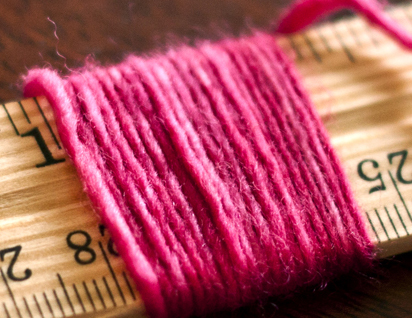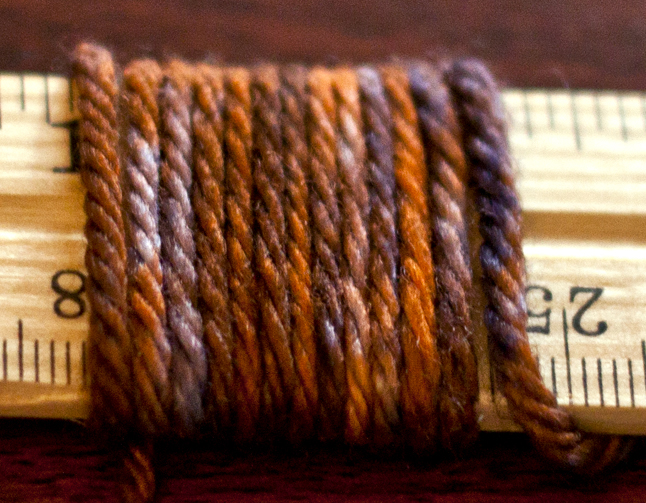A number of people have recently inquired about yarn weights and associated meanings, so I decided it was time to dive deep into the topic and explain some things. There are a number of things that are added on to yarn tags that don’t always provide useful information, such as icons from the Standard Yarn Weight System, gauge ranges, and recommended needle sizes. I believe they are arbitrary pieces of information, and I will explain why below.
Standard Yarn Weight System
The Craft Yarn Council of America defined the Standard Yarn Weight System with 7 different size designations. Each size (or weight) is assigned a name and a number:
0 Lace
1 Superfine
2 Fine
3 Light
4 Medium
5 Bulky
6 Super Bulky
Although most yarns from big box stores (Hobby Lobby or Michaels) have this notation on them, the fact that they have “standard” in their name is a bit of a misnomer. Sadly, there is no agreed standard with anything regarding yarn, and the only truly useful piece of information for yarn weights is called wraps per inch, or WPI. To measure WPI, you can wrap the yarn around a ruler (or similar measuring device) and depending on how many times it can comfortably wrap around the ruler in the space of an inch determines which category of weight it falls into. In the spirit of loose standards, the restrictions of the categories can be subjective depending on the source.
Recommended Needle Size
Another thing that is commonly listed on yarn is the recommended needle size. I’ve been asked by a beginning knitter a few times this week if she should buy a certain needle to go with the yarn she purchased. I advised her to buy needles for patterns, not for what is recommended on the yarn. Why is this? Because a lovely ball of worsted weight yarn could recommend a size 8 needle, yet the pattern you’ve chosen asks you to use a size 6 needle. I’m certainly not against collecting knitting needles, but it’s nice to be frugal when possible. On top of the recommended needle size for the pattern, there is the issue of personal gauge with the yarn to keep in mind, which is a topic that will be discussed in a future blog post.
Yarn Weight & Ply Relationship
A third piece of information that can be often listed that can be a little confusing is the listing of a weight and then a number of plies. An example from Ravelry’s search option shows exactly this.
This references back to when factories were only able to spin one thickness of singles, but it could be plied together as many times as needed to get the appropriate thickness.
"3/2"?!?
A final piece of information that is more often seen on cones of yarn is a designation similar to the format “3/2” in regards to weight. These are usually on yarns that are meant for weaving, and in the US 3/2 would mean size then plies, and to further confuse things, it’s the opposite in Great Britain.
Now, we will go through all of the different weights from thinnest to thickest that Fiber Hound carries, with some brief mentions of others.
Basenji is 22 WPI
Lace
WPI: 18+
Ply: 1-2
Other Names: cobweb, crochet thread
Lace is the category in which very fine yarns are stuck in, which means there’s a fair amount of wiggle room for what could be considered a lace yarn. Cobweb is the term used for extremely fine yarns that, much like their namesake, could be as thin as a spider’s silk. The word “lace” is heavily derived from terms meaning net or snare, which brings to my mind lacey shawls. Fiber Hound’s Basenji is on the relatively heavier side of lace, achieving a 22 WPI, while Saluki is a finer 24 WPI.
Italian Greyhound is 20 WPI
Sock/Fingering
WPI: 14-22
Ply: 3-4
Other Names: baby
Many people use the terms “sock” yarn and “fingering” yarn interchangeably, but there can be a minor difference. In regards to thickness, fingering weight yarns are a little thinner than sock yarns. As well, when the term “sock” is associated with a yarn, it could be assumed that the yarn would be a good choice for socks; this is not always the case, and can be misleading. The origin of the term “fingering” is derived from fingram, from the French fin grain, which means “fine grain”. In relation to yarn, this could imply that it is a more fine weight of a yarn. Fiber Hound's Italian Greyhound is the thinnest of the three fingering weight yarns at 20 WPI, Dachshund is 18 WPI, and the luscious Borzoi is 16 WPI.
Bluetick Coonhound is 14 WPI
Sport
WPI: 12-18
Ply: 5
Other Names: baby
The name of this weight confused me when I first saw it as I couldn’t understand what sports had anything to do with knitting. While the name is not actually related to athletics, the yarn weight is preferred for “sportwear” and associated clothing. Fiber Hound's Bluetick Coonhound is 14 WPI.
Afghan Hound is 14 WPI
DK
WPI: 11-14
Ply: 8
Other Names: light worsted
DK stands for double knitting (or double knit), which is a reference to having two thinner yarns being plied together to make a thicker yarn. There appears to be a few different anecdotes floating around in regards to the origins. The first story is the yarn weight’s use in WWII, where factories in Great Britain frugally created size between sport and worsted that could “double” for either in the final product. The second origin cites the weight being doubled up from fingering weight. Fiber Hound's Afghan Hound is 14 WPI.
Norwegian Elkhound is 13 WPI
Worsted
WPI: 9-11
Ply: 10
Other Names: afghan, aran
The term worsted finds its origins from “worstead”, the name of a village in Norfolk in which yarn and cloth were crafted. The term often causes confusion because of the spinning term worsted (in contrast to woolen). Worsted in regards to spinning means that the yarn is smoothly spun with the fibers prepared in a method that makes them parallel to each other. Woolen can mean anything that does not fit into the worsted category, and the resulting yarns are often much more lofty and fluffy. Neither of these things matters when referencing yarn weight, but they’re important to know for context. Aron (pronounced Aaron) yarns are often considered being thicker than worsted weight yarns. Fiber Hound's Norwegian Elkhound is 13 WPI.
You may have noticed that a couple of the yarns are also known as “baby”. I have not yet discovered the origins of this, but I suspect the designation is an attempt to point customers into the idea of “this is good for baby garments”.
I find the differences in yarn weights to be highly arbitrary and subjective, and if I had a say in anything, I would remove all the names of the yarns and go entirely by WPI, but I do not see that happening in the near future. Each yarn company and mill has their own ideas of which yarns fit into what category which can cause more confusion for our customers.
If you had to choose one option to go by to sort the weights of yarn, what would you choose? Do you have a better solution?
Sources:
http://www.craftyarncouncil.com/weight.html
http://www.knittersreview.com/forum/topic.asp?TOPIC_ID=88945
http://knitting.about.com/od/yarn/f/Does-Ply-Have-Anything-To-Do-With-Yarn-Weight.htm
http://en.wikipedia.org/wiki/Yarn_weight
http://www.ravelry.com/help/yarn/weights
http://www.etymonline.com/index.php?term=fingering&allowed_in_frame=0
http://en.wikipedia.org/wiki/Worsted
http://www.kathys-kreations.com/tips/page95.html
http://www.etymonline.com/index.php?term=lace
http://kws.atlantia.sca.org/Woolen_vs_Worsted_Explained.pdf















